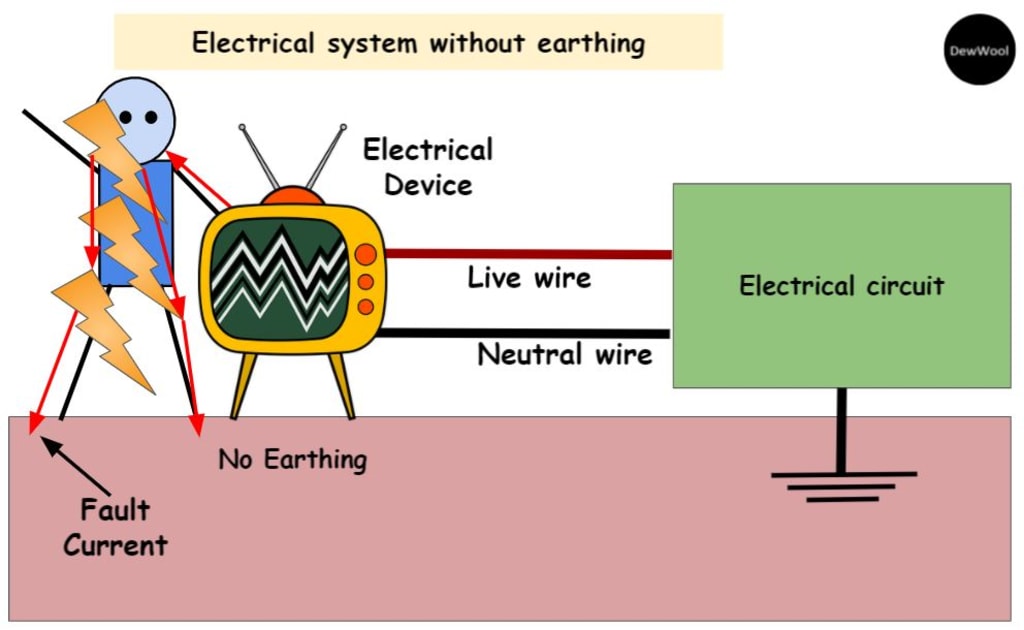
Title: Understanding Electrical Earthing: A Comprehensive Guide
Introduction:
Electrical earthing, also known as grounding, is a vital aspect of electrical systems that ensures the safety and efficient operation of various electrical equipment. It plays a crucial role in protecting individuals from electric shock and preventing damage to electrical installations. In this blog post, we will delve into the concept of electrical earthing, its significance, and its different types.
Electrical earthing refers to the process of connecting electrical equipment, devices, and systems to the ground or earth. It involves establishing a conductive path to dissipate electrical faults, surges, and static charges safely into the ground, thereby preventing damage to the equipment and reducing the risk of electric shock.
Significance of Electrical Earthing:
a. Protection against electric shock: Proper earthing provides a low-resistance path for fault currents to flow into the ground, thereby minimizing the risk of electric shock to individuals who come into contact with electrical equipment.
b. Equipment safety: Earthing helps to protect electrical equipment from damage caused by electrical surges, lightning strikes, or faults in the system. It facilitates the diversion of excessive currents to the ground, preventing damage to sensitive electronic components.
c. Interference reduction: Grounding eliminates unwanted electrical noise or interference, such as electromagnetic interference (EMI) or radio frequency interference (RFI), which can disrupt the operation of electrical devices and systems.
d. Lightning protection: A well-designed earthing system can effectively direct lightning currents into the ground, safeguarding structures and equipment from lightning strikes.
Types of Electrical Earthing:
a. Protective Earthing: This type of earthing is primarily focused on protecting individuals from electrical shock. It involves connecting the conductive parts of electrical equipment to the earth via an earthing conductor. This ensures that any fault current flows through the earth, tripping protective devices and minimizing the risk of electric shock.
b. System Earthing: System earthing, also known as neutral earthing, involves grounding the neutral point of an electrical system. It provides stability, helps maintain balanced voltages, and ensures proper functioning of electrical distribution systems. System earthing methods include solidly grounded, impedance grounded, and ungrounded systems, each having specific applications.
c. Lightning Earthing: This type of earthing is designed to protect structures and equipment from the damaging effects of lightning strikes. It involves installing lightning conductors or lightning rods that intercept the lightning strikes and safely divert the currents into the ground, preventing electrical damage.
Components of an Earthing System:
a. Earth Electrode: An earth electrode is a conductive element, usually made of copper, galvanized steel, or a combination of metals, which establishes a connection between the electrical system and the earth. Common types of earth electrodes include earth rods, plates, and grids.
b. Earthing Conductor: The earthing conductor, often made of copper or aluminum, is used to connect the electrical system to the earth electrode. It ensures a low-resistance path for fault currents to flow safely into the ground.
c. Earth Mat: An earth mat, also known as a grounding grid, is a network of interconnected conductors buried in the ground. It provides a low-resistance path for fault currents and is commonly used in substations, power plants, and large industrial installations.
d. Earth Resistance: Earth resistance measures the resistance encountered by current flowing through the earth electrode. It is essential to maintain a low resistance value to ensure effective earthing and fault current dissipation.
Earthing Standards and Regulations:
Electrical earthing practices are governed by various international standards and regulations to ensure safety and consistency across different electrical installations. Some well-known standards include the International Electrotechnical Commission (IEC) 60364, National Electrical Code (NEC), and International Residential Code (IRC). Local electrical codes and regulations also provide guidelines for earthing systems in specific regions.
Conclusion:
Electrical earthing is an essential aspect of electrical systems, offering protection against electric shock, equipment damage, and electrical interference. Understanding the different types of earthing and implementing appropriate earthing systems in accordance with standards and regulations is crucial for ensuring the safety, reliability, and optimal performance of electrical installations. By prioritizing proper earthing practices, we can mitigate risks and create a secure electrical environment for both individuals and equipment.





Comments
There are no comments for this story
Be the first to respond and start the conversation.